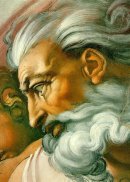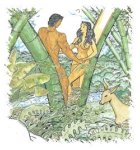Philippine Myths and Philippine Mythology
Philippine myths and superstitions are very diverse
Despite undergoing a standardized evolutionary transition from a traditional to a modern society, Philippine culture today still retains the prevalence of mythology which continues to be strong, especially in the provinces.
Some Filipinos, even though heavily westernized and Christianized, still believe in such entities, characterized by myths, legends and superstitions.

Bathala (God)
Because the country has many islands and is inhabited by different ethnic groups, Philippine mythology and superstitions are very diverse. However, certain similarities exist among these groups, such as the belief in Heaven, Hell, and the human soul.
Bathala (God)
Like other countries all over the world, the belief in God is part of the ethnicity of Philippine history. Ancient Filipinos called their God Bathala (Supereme Being and Creator) addressed as Maykapal (Creator). Bathala, was the Supreme God of the ancient Tagalog and King of the Diwatas.
Derived from the Sanskrit term Bathara Guru (for the same deity), the concept of Bathala, as with many beliefs in pre-Hispanic Philippines, a huge debt is owed to the Hinduism of the Srivijayan Javanese.
All of these beliefs were soon changed after the Spaniards set foot on the islands. Spanish missionaries used Bathala as a way for them to convert the Tagalogs into Christianity by associating him with the Christian God.
They also did this to the other deities by replacing them with saints. Since then, the name "Bathala" was used to refer to the Christian God and is still used by Filipinos today, and God is even addressed as "Poong (Lord) Maykapal".
Bathala has counterparts in other parts of the Philippines.
In Northern Luzon, Kabunian and Lumawig; in Southern Luzon, Gugurang and Mangindusa; and in the Visayas, Abba, Kan-Laon, and Kaptan.
Tales
There are many different creation stories in Philippine mythology, originating from various ethnic groups. One of the most popular stories is the tale of Malakas (Strong) at Maganda (Beautiful). Malakas and Maganda is about the origin of the native Filipinos. Below is a synopsis of the story;

When Bathala (God) was done creating the world, he was bored. He looked down over the earth and sent a bird into the world. The bird was flying around when it heard some sounds and tapping somewhere in the forest. The bird landed and found out that the sound is coming from a huge bamboo.
He started pecking on it and pretty soon it split in the middle where a man came out of it. His name was Malakas, which means strong, and he told the bird, "My mate is in the other piece of wood." They got her out and her name was Maganda which means beautiful.
The two got on the bird's back and flew away to find some place to live. They went flying around the world, and then finally, the bird saw a land and let the two giants set foot and live on it. When Malakas and Maganda stepped on the land their weight separated the land into islands. Malakas and Maganda live on and produced millions of children, which came to be the Filipinos.
Mythological Creatures
Filipinos also believed in mythological creatures. The Aswang is one the most famous of these Philippine mythological creatures. The aswang is a ghoul or vampire, an eater of the dead, and the werewolf.
There is also the (Agta) a black tree spirit or man. Filipinos also believed in the Dila (The Tongue), a spirit that passes through the bamboo flooring of provincial houses, then licks certain humans to death.
Filipino mythology also has fairies (Diwata and Engkanto), dwarfs (Duwende), Kapre (a tree-residing giant), Manananggal (a self-segmenter), witches (Mangkukulam), spirit-summoners (Mambabarang), goblins (Nuno sa Punso), ghosts (Multo), fireballs (Santelmo), mermaids (Sirena), mermen (Siyokoy), demon-horses (Tikbalang), (Hantu Demon), demon-infants (Tiyanak), and the (Wakwak) a night bird belonging to a witch or vampire or the witch or vampire itself in the form of a night bird.


